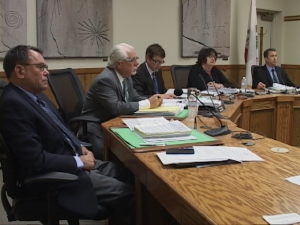 With the issue of large-scale solar development on the front burner, the Inyo Supervisors and Administrator took a look back on Tuesday to show the public where the County has been when it comes to solar regulation. That took them to an ordinance called Title 21.
With the issue of large-scale solar development on the front burner, the Inyo Supervisors and Administrator took a look back on Tuesday to show the public where the County has been when it comes to solar regulation. That took them to an ordinance called Title 21.
That ordinance spells out how solar developers need to apply for permission to build Renewable Energy projects. County Administrator Kevin Carunchio said Inyo County has worked on solar issues for over four years. He said greenhouse gas cutback mandates started in 2008 with tax money available for Renewable Energy projects.
Carunchio told how former DWP Manager David Freeman took him and others on a tour of Owens Dry Lake with plans for solar arrays there. Also present was a list of heavy hitters – the President of the California Energy Commission, the head of the Public Utilities Commission and the Clinton Climate Change Foundation. They were all interested in DWP land, said Carunchio, for solar development east of the Owens River.
Prompted by that eye-opener, Carunchio asked the County Counsel and Planning to research the County’s authority regarding Renewable Energy development. He said all recognized the threat of development on DWP’s 300,000 acres. Carunchio said, “The County has very little authority.” He called the last four years “a search for relevancy” in the Renewable Energy process. Where does the County fit in and with how much control?
Enter Title 21 which is based on the County’s police power to protect the health, safety, and welfare of citizens, the environment and public trust resources. Attorney Greg James said case law shows that the public trust doctrine “may allow Inyo to prevail in court over DWP.”
Title 21 requires solar or wind developers to apply for a permit, the County to assess impacts, or work out a Renewable Energy Development Agreement between the Board of Supervisors and the energy developer. The County can require mitigation, a reclamation plan, and payment for impacts on services.
Carunchio made it clear there is virtually no community benefit from these projects. The County can try to get payment for service impacts, but the projects are exempt from paying property taxes.
The County’s discussion of Renewable Energy regulation essentially said Title 21 and some other planning regulations allow the County to rattle swords with some effectiveness. Beyond Title 21, power projects are supposed to comply with the General Plan. The default regulation, according to Greg James, is a permit under Title 21.
Nancy Masters asked the Board what kind of involvement the public can expect in the Title 21 process. James said Environmental Quality Act compliance includes the public. He said a Development Agreement is actually an ordinance which could be overturned by public referendum or initiative. The Agreement would also be open to general public review.
James also made it clear that LADWP holds to its position that Inyo planning regulations do not apply to their lands in the Owens Valley. He said DWP “politely refused” to apply for a permit for their Solar Ranch plans south of Independence.

















A rapid shift to less-polluting energy will be needed to avoid catastrophic global warming, because global emissions of heat-trapping greenhouse gases have accelerated to unprecedented levels, the United Nations reports today. These emissions — largely from the burning of oil, gas and coal — grew more quickly between 2000 and… Read more »
I should have added that the California Energy Commission and BLM has sole approval authority for solar thermal projects. That was written into legislation because promoting solar energy is considered an urgent state wide priority and the Legislature did not want county and local governments holding up these projects with… Read more »
Go back are read the 1979 Solar Power Bill of Rights, legislation that was passed by both houses of the State Legislature and signed into law by Governor Brown. If you read it you will see it was written to prevent local and county governments from having veto power over… Read more »
LADWP would be regulated by the CA PUC, however, on this…and THAT agency needs to be educated, lobbied and informed and it also has “a public” input, besides Title 21. Local, William Symons, Jr. (my uncle) was on that Commission once, appointed by Ron Reagan. I visited/listened to approval issues… Read more »
CPUC does not have regulatory authority over municipal utilities. They only have authority to regulate privately held investor owned utilities like Sempra, PG&E, Edison, etc. Municipal utilities are regulated by the elected City Councils of the cities that own their utilities. There would be a constitutional problem with a state… Read more »
Hey Supervisors, if your going to screw up my back yard in the name of free power, at least give me some of that free power in exchange. Or am I just screwed again? DWP giving the county kick backs does nothing for my checking account!
I hear you. But so far, the only thing LADWP has offered is tourism as a replacement for agriculture and ranching. And really, what does Inyo or Mono County have to give other than what LADWP leaves on the table? Don’t hold your breath where LADWP can see it. They’ll… Read more »